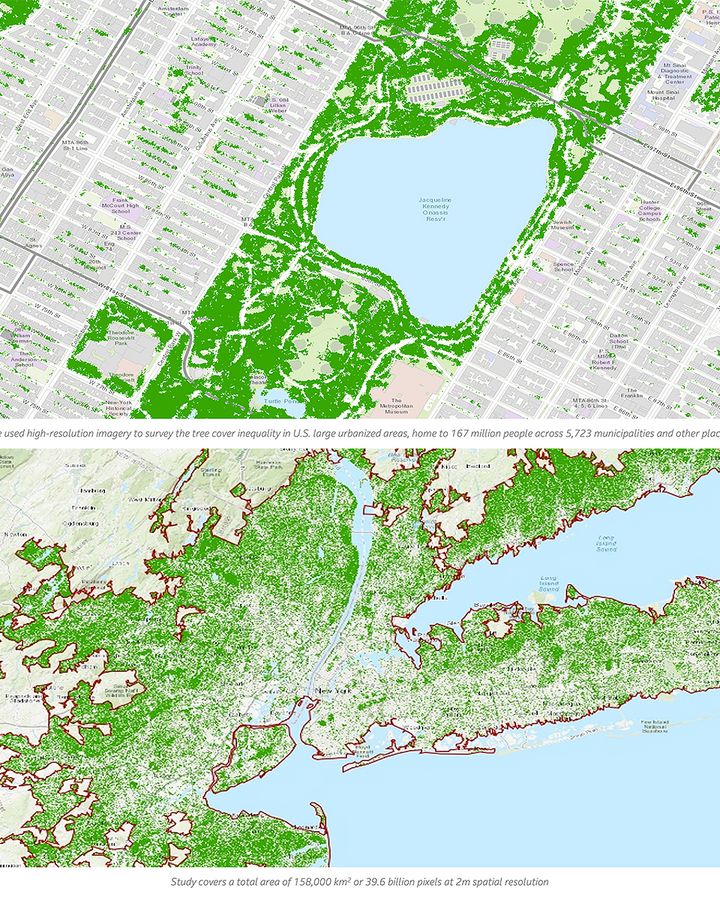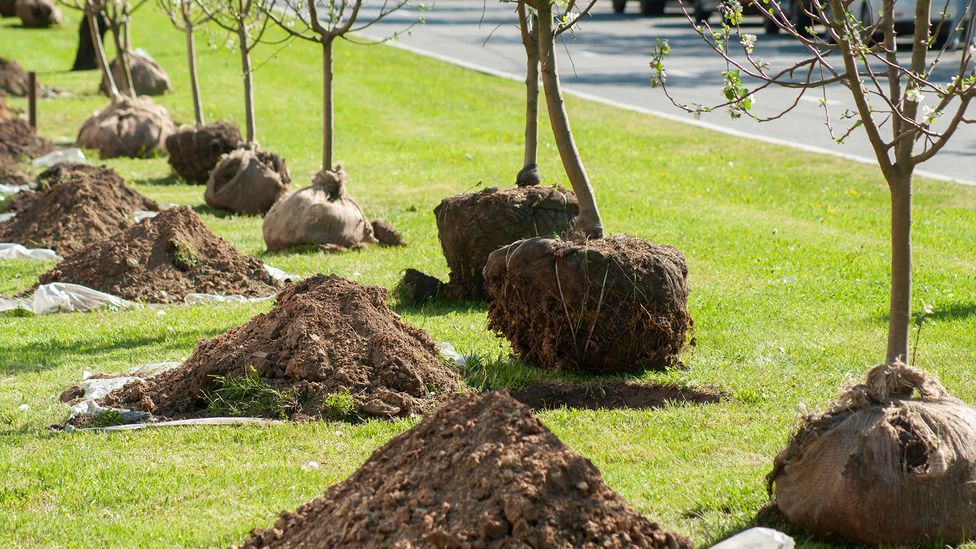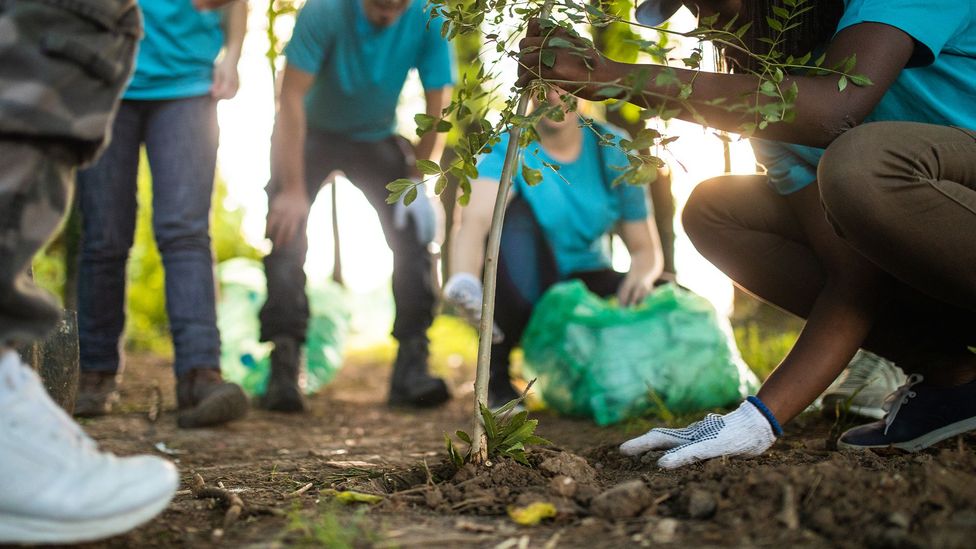Every weekend, a group of volunteers plant up to 50 trees in Soundview Park in New York City. Its 205 acres (83 ha) line the last mile of the Bronx River and are home to eastern box turtles, rare migratory birds and a family of coyotes. Many of the planters have been giving up their Saturdays for years. "Once you put your hands in the dirt, you feel like part of the park," says John Vallacchi, a coordinator for the environmental justice non-profit the Bronx is Blooming.
Just across the river are the communities of Hunts Point and Longwood, where 94% of its roughly 160,000 residents are people of colour. Among depots and dense apartment buildings is the largest food distribution centre in the world, Hunts Point Terminal Market. Up to 13,000 diesel trucks travel to the centre through this neighbourhood every day.
This is one factor contributing to the area's air pollution levels, some of the highest in the city. Despite its proximity to Soundview Park, the neighbourhood has "really low amounts of vegetation and experiences extremely high urban heat island impacts", says Victoria Sanders, the climate and health programs manager at the NYC Environmental Justice Alliance. "It'll be significantly hotter in one place than the other because of the investment [in green spaces] that one has gotten and the other has not."
The hope for each tree planted in Soundview Park is that it will sequester carbon, improve air quality, and help absorb water when storms hit. But planting a tree just over the river, on a busy stretch of sidewalk in a dense residential area, could have even greater benefits, according to new research.

New York City's Longwood neighbourhood (pictured left) is an urban heat island that could benefit from targeted tree planting (Credit: Getty Images)
It's well known that greater access to nature has a range of benefits, such as improved cognitive function, blood pressure, mental health, physical activity and sleep. (Read more about the groups tackling racial inequality in green spaces.) Across the US, minority neighbourhoods have 11% less tree canopy and 14% more artificially built surface area, such as asphalt and cement, than majority-white neighbourhoods.
This disparity is greatest in the north-east of the US. Here, cities are characterised by dense centres of minority neighbourhoods and leafier suburbs as well as exurbs where white communities are more likely to reside.
"Certain communities were excluded from having services like trees and all of the cooling and cleansing benefits that they provide," says Benita Hussain, the chief programme officer for tree equity at the non-profit American Forests.
A new study by researchers at The Nature Conservancy has calculated just how much health and energy benefits an ambitious and targeted tree-planting programme across the US would have. Targeted planting in areas historically lacking trees – which are predominantly communities of colour – would pay for itself in the health and power bills it would offset, the researchers found.
Across white neighbourhoods in the U S, greater tree cover is already linked to 190 fewer deaths, 30,000 fewer doctors' visits, and 1.4 terawatt hours less electricity use each year than in minority areas. By planting trees strategically in the areas where they are most needed, an additional 460 heat-related deaths and 81,000 heat-related illnesses could be averted, and another 4.3 terawatt hours of electricity could be saved each year, the researchers estimated.
It might be easy to say, 'Let's plant a tree in the middle of a park,' but that tree will not have as much of a distributed impact as planting one in a community of colour underserved by trees – Nneka Sobers
For decades, many cities, such as Portland and Baltimore, have made urban reforestation a part of their climate-mitigation efforts. Each has its own set of motivations, which guide strategies. According to the paper, those centred on carbon sequestration direct planting to areas with ample space, often predominantly white suburbs or existing forests. Those prioritising heat-risk reduction, though, which target densely settled areas with low tree canopy cover, face particular challenges, including lack of plantable area and poor soil quality.
"It might be easy to say, 'Let 's plant a tree in the middle of a park,' but that tree will not have as much of a distributed impact as planting one in a community of colour underserved by trees," says Nneka Sobers, an urban designer and the assistant director of product development at Cornell University's Urban Tech Hub.
In New York City, only 17% of the city's seven million trees are in areas populated largely by people of colour. In the summer these neighbourhoods warm by on average of 0.95C (1.7F) more than predominantly white neighbourhoods. "That means that people in those communities have around a 4.3% greater heat wave mortality risk than the average person in a majority-white neighbourhood," says Rob McDonald, The Nature Conservancy paper's lead author.

Only 17% of New York City's 7 million trees are in areas populated largely by people of colour (Credit: Getty Images)
Some efforts have been made to address this disparity in the past two decades, but advocates say it can be hard to rely on short-term budgets tied to changing administrations, especially when "as soon as the budgets get tight, parks get cut", says Adam Ganser, executive director of the non-profit New Yorkers for Parks.
There has, however, been new investment to address this issue. In 2022, the Inflation Reduction Act earmarked $1.5bn (£1.2bn) organisations focused on urban forestry working in historically underserved communities.
In 2023, New York City planted more than 13,000 saplings, a record year. According to the Parks Department, more than one third were planted in neighbourhoods that ranked high on the heat vulnerability index, which accounts for factors like green space, access to air-conditioning, and percentage of low-income or black residents. Soundview, the neighbourhood abutting the park by the Bronx River, received trees. However, nearby Hunts Point and Longwood did not.
Carbon Count
The emissions from travel it took to report this story were 0kg CO2. The digital emissions from this story are an estimated 1.2g to 3.6g CO2 per page view. Find out more about how we calculated this figure here.
Bronx is Blooming was the only NYC non-profit to be awarded funding, which will allow for more targeted planting than they've been able to plan for in the past. To start, 5,000 trees in Highbridge, a predominantly Dominican and Puerto Rican neighbourhood north of Yankee Stadium. "We're working with the community now to see where they could see the most benefit and what makes the most logistical sense in terms of taking care of the trees for a sustainable amount of time," says Vallacchi.
The city passed a bill in October to increase its canopy from 22-30%. To ensure viability, the city council also called for the creation of a comprehensive action plan to be completed by July 2025.
But whether it has the resources to care for these trees is another issue. "When you create a goal of planting, say, 100,000 trees, there's an upfront capital cost, but it also adds considerable operations and maintenance costs for the parks department," says Ganser. "If you don't have that back-end funding in place, you're not protecting the investment."

Across the US, minority neighbourhoods have 11% less tree canopy than majority-white neighbourhoods (Credit: Getty Images)
Funding allocations have long been dwarfed by the park system's $590m (£470m) in deferred maintenance, the result of decades of underfunding and constrained staffing, according to New Yorkers for Parks. In 2023, NYC Parks, which manages 30,000 acres (12,100ha) of land, as well as hundreds of thousands of street trees, received roughly 0.6% of the city's operating budget; in 2024, its budget share is projected to be the same. By comparison, most major US cities spend 1-2% of their budgets on park operations and maintenance.
"While the city budget is large compared to many other cities, the portion that is allocated to parks isn't that much given the amount of overall land area that is urban forest," says Mike Treglia, a lead scientist at the Nature Conservancy.
According to researchers, increasing national tree cover by an additional 5% with a focus on communities of colour would cost $29m (£23m) in planting and maintenance costs per year, but provide $32m (£26m) in benefits. That focus on the areas in most need of trees could make all the difference financially: if those saplings were split more uniformly among all neighbourhoods, the expenses would exceed gains.
You may also like:
• The 'messy' alternative to tree planting
• Why climate change is inherently racist
• Tree planting is bringing clean water to a tropical nation
In August, a group of design researchers at Cornell University launched Tree Folio in hopes of helping planners think more critically about local context. The 3D mapping tool uses light detection and ranging (lidar) to create a map on the scale of individual trees, accompanied by data on the amount and quality of shade each provides.
The data is extremely granular – and that's the point. "It comes down to the idea that climate change is experienced very differently at the individual level," says Alex Kobald, a research associate at Cornell University and the tool's lead designer.
For instance, planting a tree on an east-west street that would be more exposed to the Sun throughout the day has far more impact than on a north-south one, especially in built-up neighbourhoods. Or, Sobers says, "Maybe you could plant a tree by a bus stop, because that means more people actually get to experience its shade."
The Tree Folio team hopes its tool will encourage even more community-led planning around trees. "There's always a temptation to quantify the big picture of climate change to mobilise a response," says Kobald. "But the datasets and processing abilities we have today allow us to produce a thousand unique solutions to the one big problem."
--
For essential climate news and hopeful developments to your inbox, sign up to the Future Earth newsletter, while The Essential List delivers a handpicked selection of features and insights.
